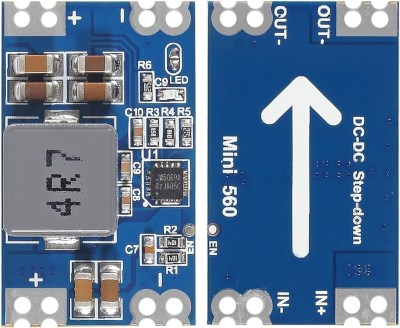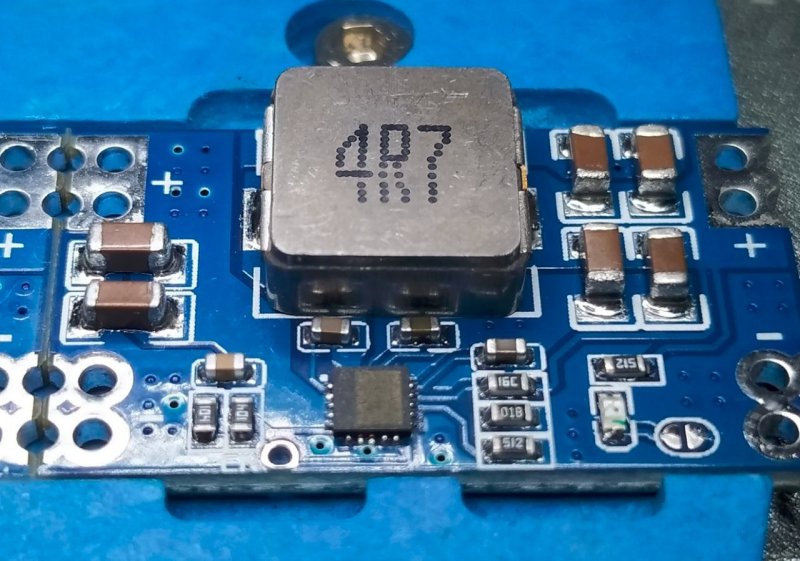Some of us may have recently stumbled over these mysterious ‘Mini 560’ synchronous buck converter modules at various e-shopping websites. These little modules claim to take in 7-20 VDC and output whatever voltage they’re configured for (e.g., 5 VDC). What IC is used on these modules? Since the IC on these modules has had its markings laser-etched away, answering that particular question is a tedious sleuthing job. Fortunately, [MisterHW] has done the legwork for us already, with a detailed write-up.
Details like the nominal input rating, measured currents, and resulting efficiency values provide clues. Looking at the 0603 SMD resistor values for given output voltages provides the programming resistances, combined with the footprint of the QFN-20 package. After desoldering the IC on a sample board, the footprint was reminiscent of certain Texas Instruments (Ti) packages, leading to a perusal of the Ti parametric database and a couple of candidate matches.

The other provided parameters for the Mini 560, such as the 500 kHz frequency, narrows things down to two Ti parts: the TPS51397A and TPS56C230. The latter only accepts up to 18 VDC unless you look at the absolute maximum ratings, which matches the 20 VDC. The pin-out of the TPS56C230 also matches the Mini560 IC, but looking deeper, there’s no good match.
Catching a lucky break, [MisterHW] got pointed to the JoulWatt JW5069A, which, as it turns out, is a good match, including the odd footprint with bridged pads. Googling for this part number even led to images of the Mini 560 module without the laser-etching. It looks like JoulWatt may have been founded in China in 2013 to provide drop-in alternatives for Western parts like those from Ti (with the JW5068A also very interesting), but it still doesn’t really explain the laser-etched markings unless these parts aren’t designed for the export market? Some mysteries may never truly be solved, it seems.
Of course, we’ve seen other buck converter modules that are less mysterious. Want to know the theory behind it? We got you.

















The way the chinese manufacturing sector works, anything that sells and can be cloned *will* be cloned. So the laser etching is an attempt to obscure an otherwise trivial design so the original manufacturer can’t easily be undercut by a competitor.
Correct, the etching is mainly done to twart domestic competition
I’ve run into this with charge pumps. Which were very expensive on Mouser but cheap where they were being used in production. For which I eventually figured out the part number and ordered through Alibaba. And they shipped out of Germany. Sweet mysteries of life.
Alibaba and/or their freight partners have warehouses in Germany, Frankfurt if I recall (same as dhl).
I would be surprised if these boards used a western-brand IC such as Texas Instruments. Even if [MisterHW] found a perfect match, it would be safe to assume that the IC is a clone with matching specs.
That’s exactly what the article says… It’s a Chinese TI clone company.
I used a similar little smps board with an 8 pin ic.
the thing was, within a single batch of 10 boards from 1 vendor, there were 3 variants of the pcb layout. they varied in subtly in the high current area with two of the 3 missing a via – it hadn’t been drilled, but was dotted.
very subtle, but 2 of the 3 unstable and extremely rf noisy because of poor high-current/sense point isolation. The third, and of course the one I tested, was ok(ish)
I actually am very not surprised that Chinese SILICON companies copy western stuff. I mean, most countries of the world don’t even have the money and resources to have a silicon supply chain, and the Chinese are simply copying stuff, how crazy.
I mean, they could easily DO their own stuff, innovate and generate value, but keep just copying.
Such parasitism is a winning strategy under the forces of the market though. It’s doubly rewarded: much lower development costs to recoup, and it harms the competition.
As hardware developers, we can only fight our addiction to cheapness by demanding better distribution with a higher degree of automation and lower markup, and reward Western manufacturers when they support the hobbyist communities and the professionals which they produce.
>much lower development costs to recoup, and it harms the competition
But ultimately it’s always playing the second fiddle. See for example what happened to the computer electronics industry in the DDR when the west developed better manufacturing technologies and the Soviets couldn’t keep up because they were relying on reverse-engineering western products and didn’t have access to the technology that made them.
It’s the same thing as how it took decades for the Chinese to develop the manufacturing technology to make ballpoint pen balls for the two cent pens they were exporting. They were importing the balls from Switzerland all that time, because the Swiss refused to show them how it’s done.
Indeed, the actual problem is that the corporations that are getting copied are willing victims. It’s just too lucrative to off-shore manufacturing to China because of poor environmental regulations, poor worker rights, and the local state subsidies to exports industries, so they’re basically handing the technology on a silver platter to the copycats. If the factories were in the US or EU, or anywhere else really, the Chinese couldn’t do jack because the hierarchical top-down system and “don’t question your superiors” culture doesn’t reward innovation and risk taking. The nail that sticks out gets hammered down and all that.
That’s a poor and now antique way of thinking. China is now ahead in terms of innovation and we, as western citizens, are lagging behind. Sure, you’ll still find parasitic sellers for parasitic demand (since there’s still a demand for it), but if you spend a bit more time searching the inner marker (: not via alibaba or aliexpress), you’ll find better products of much higher quality than what you could find in western countries for a small portion of the clone’s price. The chip will be unknown to you, you’ll never find an english datasheet for it, yet the performance will be much better than the equivalent in US.
Just as you now find the best micro display in China, the best battery in China, …
>Just as you now find the best micro display in China, the best battery in China, …
Developed and made with technology stolen from western fabs.
“China is now ahead in terms of innovation”
Uh, yeah, if that were true, there wouldn’t be buckets of articles out there about the Chinese working to close the gap on the highest-end stuff, like CPUs/GPUs/FPGAs/DRAM.
Stuff like displays and batteries are at the end of their tech tree, to use a game analogy.
The Chinese aren’t copying stuff because they don’t have the resources to develop their own. Their clones *are* local designs – if they were dead-duplicates of the original you wouldn’t find behavior differences.
They’re copying stuff because there’s already a market for the original.
Very nice writeup.
Regarding the high no-load current, this is very likely due to the FB resistor divider (14k3 + 1k) (EIA-96 markings 16C + 01B), which sinks a current of 590uA on the output side. With this fairly small current, efficiency will be low (probably in the 20…30% range), resulting in an average input current 2.5mA, as seen.
The TPS (TI) alternatives use resistive divider in the datasheet reference design which are more than 10 times larger, so 10 times smaller no-load current. This is probably a deficiency in the “Mini560” board, but probably a direct cause of the quite unspecific JW datasheet.
https://nixieclock.org/?p=493
NCH6100HV Nixie power supply does the same thing, etching off all the part markings. Crazy how competitive they get.